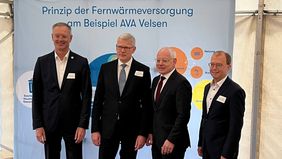
Climate-friendly heat for the Saar
Saarbrücken. Saarbrücken-based STEAG New Energies GmbH and Fernwärme Verbund Saar GmbH (FVS), together with the regional utility Entsorgungsverband Saar (EVS), have expanded the Velsen waste-to-energy plant (AVA) to include a heat extraction facility. From the 2022/2023 heating period onwards, around 170,000 megawatt hours (MWh) of heat per year will be fed into the Saar district heating network via a six-kilometer-long connecting pipeline.
The project brings the partners an important step closer to the long-term goal of decarbonizing the district heating supply in Saarland, i.e. permanently reducing the CO2 emissions created. This will make district heating, which is already climate-friendly compared with other energy sources because it conserves resources, even more climate-friendly in the future. The parties involved want to continue along this path and examine the utilization of further waste heat potential for the benefit of district heating.
“This project makes an important contribution to setting up the heat supply in Saarland in a way that is both crisis-proof and climate-friendly,” Economics and Energy Minister Jürgen Barke emphasizes. “Due to the changes in background conditions caused by the crisis and new demands on our energy supply in connection with the Ukraine war, it is important to make use of our domestic heat potential comprehensively. This will make our industrial location less sensitive to distortions on the energy markets.
STEAG stands for climate-friendly and reliable district heating supply
“We started our search for technical and energy alternatives leading to gradual decarbonization of the district heating supply in the Saar at an early stage,” says Anke Langner, member of the management board of STEAG New Energies GmbH, a subsidiary of the Essen-based energy company STEAG GmbH. “In tapping the climate-friendly heat from the Velsen waste-to-energy plant, we were able in particular to successfully bring in STEAG’s engineering and energy management expertise." These will continue to be of great importance in the future when it comes to pushing ahead with the decarbonization that has already begun and tapping further sources of heat.
EVS: from waste disposal company to resource manager
For EVS, the connection of its waste-to-energy plant to the Saar district heating network is a lighthouse project. AVA Velsen has already been feeding electricity for around 35,000 households into the public grid for a long time. Now its potential is also being used to supply heat. AVA Velsen will supply the equivalent of 16,000 households with district heating from the start of the current heating period.
“The plant therefore stands for both security of waste disposal and security of energy supply in equal measure,” says EVS director Stefan Kunz. “The consistent use of existing green energy resources is good for the climate and for the fee burden, which will also be relieved by the expected revenue. This shows once again that the waste management industry can make an important contribution when it comes to the sustainable transformation of our energy supply,” says Stefan Kunz.
“The consistent utilization of potential at AVA Velsen for electricity and heat generation is an important milestone in EVS’s strategy on the way to increased self-generation and therefore an increasingly visible independence from existing market fluctuations and availability issues,” emphasizes EVS director Holger Schmitt.
Valuable contribution to climate protection
Today, more than 90 percent of the heating and hot water with which Fernwärmeschiene Saar (FVS) supplies its over 13,500 customers along the 660-kilometer-long pipeline network already comes from climate-friendly waste heat recovery or from resource-saving combined heat and power (CHP) generation.
For the development of the Velsen waste-to-energy plant into a CHP plant and the construction of a connecting line to FVS’s existing district heating network, the partners have together invested more than 20 million euros. The 170,000 MWh of heat extracted annually will further improve the climate balance of the district heating supply in the Saar region.
“In this project the partners have demonstrated technical and economic foresight,” as Dr. Ralf Schiele, who is responsible for Market and Technology on the management board of STEAG GmbH, summarizes. The current energy crisis as a result of the Russian attack on Ukraine shows in a drastic way how important it is to develop previously unused heat sources in order to quickly and sustainably reduce dependence on imported natural gas as much as possible. “In the end, this not only has a positive effect on the environment and the climate, but also helps to stabilize energy prices and ensure security of supply,” says Ralf Schiele.
